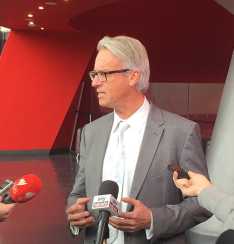Lack of Socceroos sponsor our ‘biggest challenge’, admits Football Federation boss

David Gallop addresses media after his keynote presentation at the Mumbrella Sports Marketing Summit
The chief executive of Football Federation Australia has admitted there have been no takers to sponsor the Socceroos, describing it as the “big challenge” in commercialising the sport.
Speaking at the Mumbrella Sports Marketing Summit at the Melbourne Cricket Ground this morning, David Gallop said the A-League and the women’s W-League were drawing good support from brands.
It was the reluctance of anyone to buy the naming rights for the national team that was the biggest headache.


Great sales job Gallop, based on what you’ve said why would any brand consider sponsoring our national team?
@not likely – it wasn’t a sales job, it was an industry forum. Do you think the people there would rather have gotten a sales pitch or honesty?
Asking to much Dave?
Logos and player appearances! Surely the world has moved on by now and look to connect to consumer passion through real storytelling and value add to fans. Sounds like the FFA need some 21st century thinking to position and connect Socceroo story to right fit brands.
I agree with Adam, perhaps the FFA need to think a bit more laterally about how they structure the sponsorship and how they work with brands to make the most out of the sponsorship. If they are not prepared to do that, the alternative would be to look at the second tier of sponsors, those that just want to increase brand awareness versus something more meaningful (ie. no one had heard of Wizard before they sponsored the Blues).